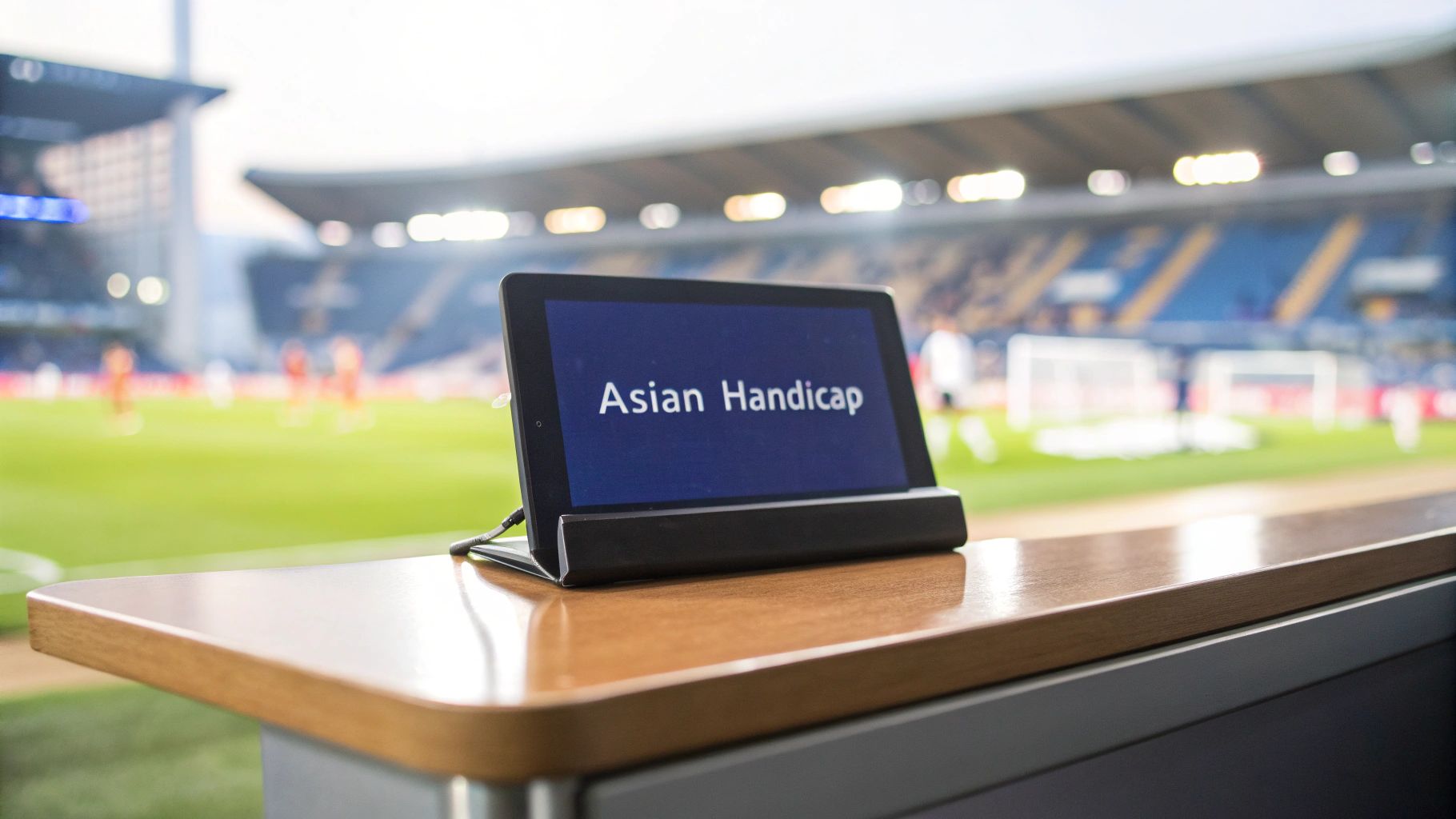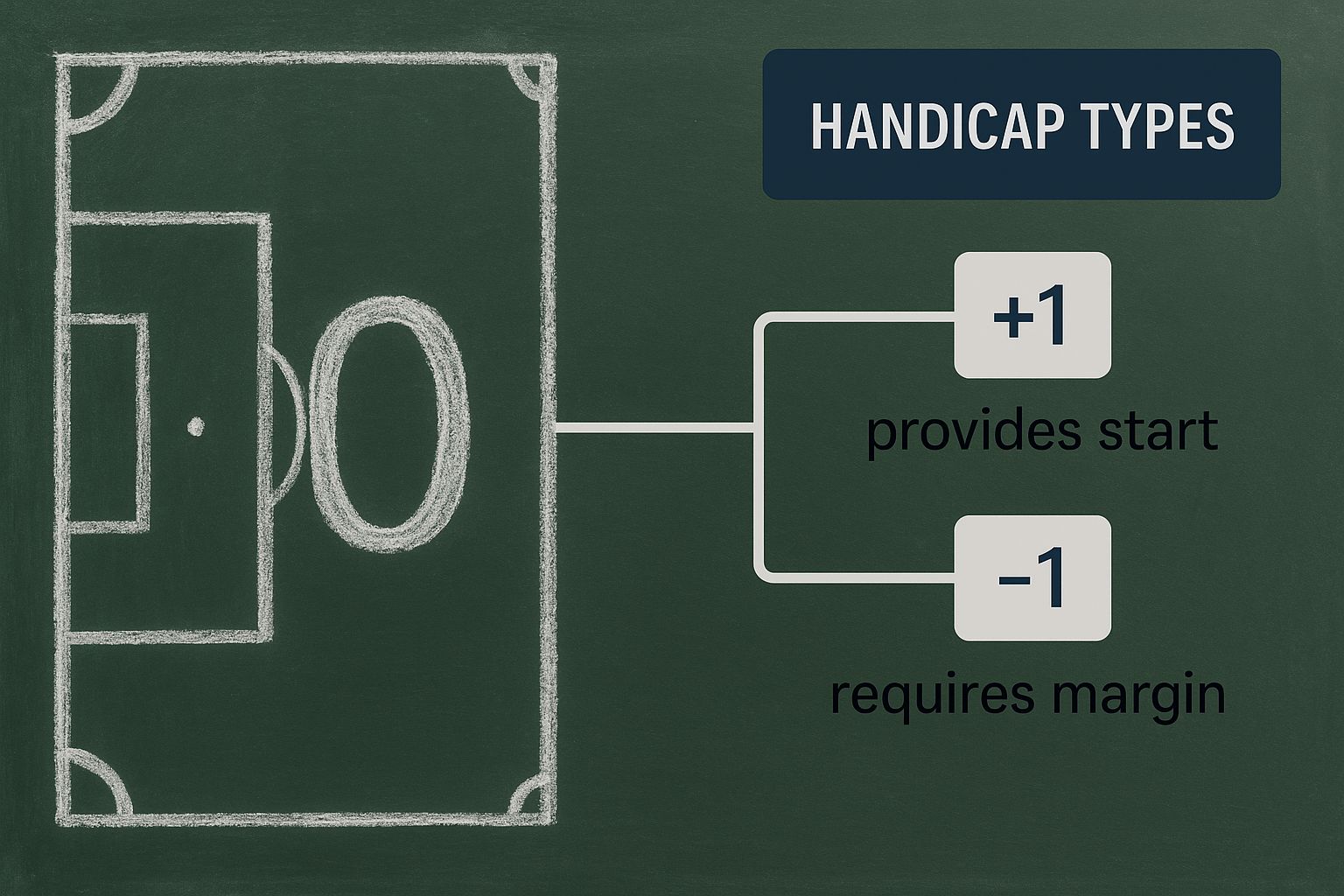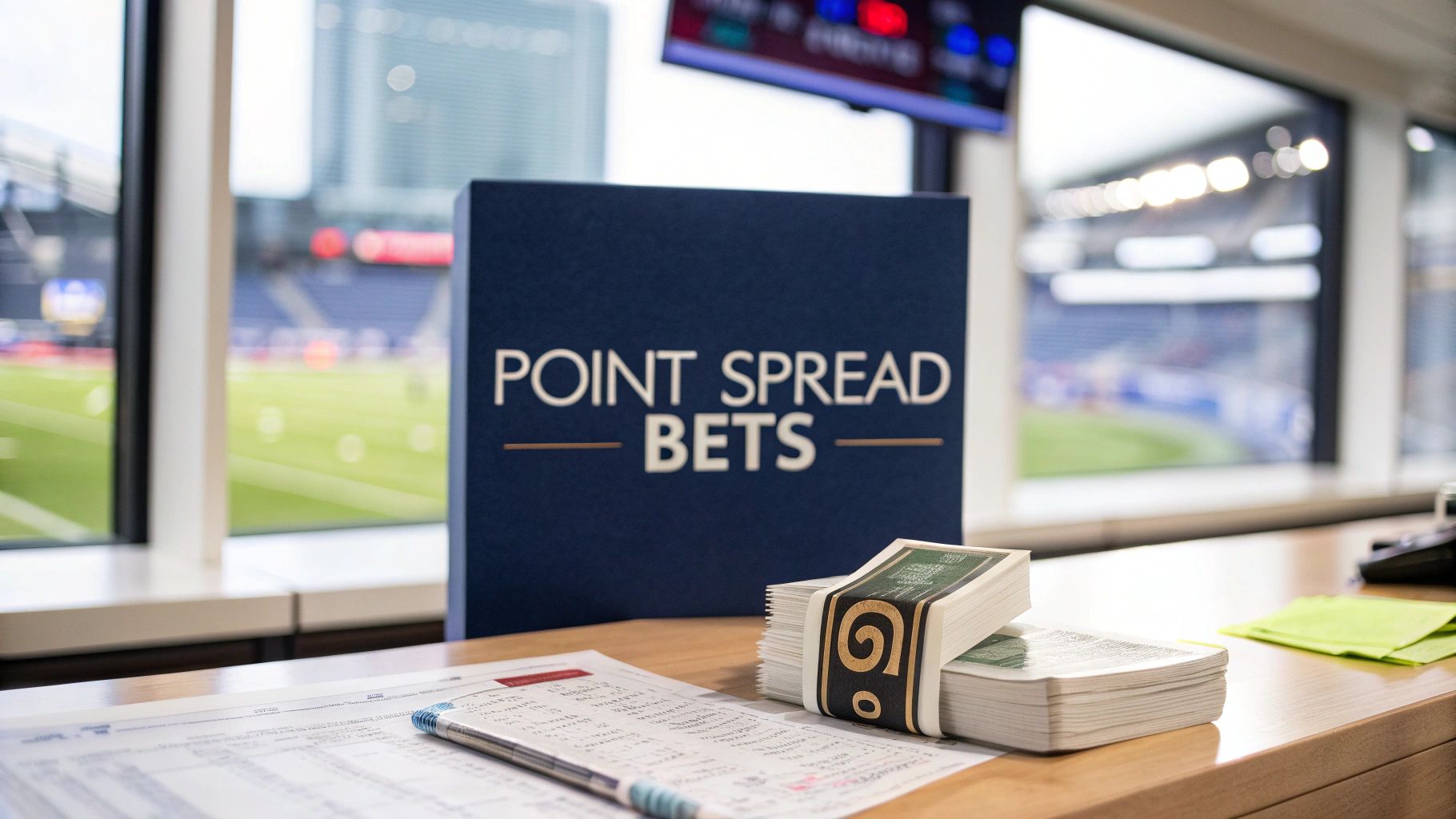
What Is Asian Handicap Betting and How Does It Work?
Unlock your betting strategy with our guide on what is Asian handicap betting. Learn how it works with real examples to gain a strategic edge.
Ever found yourself staring at a match-up where one team is a massive favourite, and the odds are just too short to bother with? We’ve all been there. This is exactly where Asian Handicap betting comes in and completely changes the game.
It's a clever way of levelling the playing field between two teams that are mismatched on paper. By applying a goal 'handicap' before kick-off, it essentially gives the underdog a virtual head start. The best part? It completely removes the draw as a possibility, turning the bet into a much cleaner, two-way contest.
So, What's the Big Deal with Asian Handicap Betting?

If you’re tired of the old win-draw-lose (1X2) market, you're in the right place. Imagine a scenario where a powerhouse like FCSB is playing a team fighting relegation. The odds on FCSB to win are probably terrible, maybe 1.15, and backing the underdog feels more like buying a lottery ticket than making a smart bet.
This is the problem Asian Handicap betting was designed to solve.
Instead of just asking “who will win?”, it forces you to ask a much more interesting question: “by how much will they win?” Think of it like a 100-metre sprint where the faster athlete starts a few metres behind the line to make it a fair race. That’s precisely what a handicap does in football—it balances the scales and makes even the most one-sided matches genuinely interesting to bet on.
To give you a quick snapshot, here’s how the two styles stack up against each other.
Traditional Betting vs Asian Handicap At a Glance
| Feature | Traditional Betting (1X2) | Asian Handicap Betting |
|---|---|---|
| Possible Outcomes | Three (Home Win, Draw, Away Win) | Two (Win or Lose) |
| The Draw | A standard outcome you can bet on. | The draw is eliminated. |
| Risk Management | All-or-nothing. You either win or lose. | Can be lower, with options for your stake to be returned ("push"). |
| Value | Often lower odds on clear favourites. | Can offer better odds and value, even on strong teams. |
As you can see, the Asian Handicap introduces a layer of strategy that standard betting just can't match.
Why Do Experienced Bettors Love This Market?
It's no secret that seasoned punters often prefer Asian Handicaps over traditional markets. Once you get past the basics covered in general guides on how to bet on football, you start to see why it's so appealing.
- You Often Get Better Value: Because it’s a two-outcome event, the bookmaker's margin is usually smaller. This translates directly into better, more competitive odds for you.
- It’s a Great Way to Reduce Risk: Certain handicap lines, like a -1.0 or +2.0, mean you can get your stake back if the outcome is a "push." This built-in safety net is a huge advantage.
- It Makes You a Sharper Analyst: You can't just pick a winner. You have to really dig into a team's form, their attacking firepower, and their defensive resilience to predict the margin of victory. It sharpens your betting mind.
In a nutshell, Asian Handicap betting is for those who want to move beyond simply guessing who will win. It’s about understanding the performance gap between two teams and finding real value where others see a foregone conclusion.
How Asian Handicap Bets Actually Work
So, how do these numbers actually play out in a real match? It’s not as daunting as it first seems. The whole point is to give one team a virtual head start (or a disadvantage) before the match even kicks off. This forces you to think beyond just who will win, and instead focus on by how much they'll win or lose.
Of course, to get the most out of this, you need to be comfortable with what the odds are telling you. If you need a refresher, our guide on how to read betting odds is the perfect place to start. It’ll help you connect the handicap lines to what you stand to win.
Ready? Let's dive into the three main types of handicaps you'll find.
Whole Number Handicaps (-1, +2)
This is the most straightforward version. A whole number handicap, like -1.0 or +2.0, is exactly what it sounds like. If you bet on a team with a -1.0 handicap, you're saying they'll win even if they start the match a goal down. To win your bet, they need to win by at least two clear goals.
But what if they only win by one? That’s where the concept of a "push" comes in, and it's a game-changer.
What is a Push? A push is essentially a do-over. It happens when the final score, after you've applied the handicap, ends in a draw. When this occurs, your bet isn't a winner, but it's not a loser either. You simply get your original stake back. Think of it as a safety net that takes the sting out of a near miss.
For instance, if you back Manchester United at -1.0 and they scrape a 2-1 victory, the adjusted score is 1-1. That's a draw, so your bet is a push and your money is returned.
Half Number Handicaps (-0.5, +1.5)
Next up, we have half numbers. Handicaps like -0.5 or +1.5 are designed with one specific goal in mind: to get rid of the push entirely. Since a team can't score half a goal, there's no way for the adjusted score to be a draw. Your bet will always be a win or a loss. Simple as that.
Backing a team at -0.5 is one of the most common bets you'll see. It’s effectively just a bet on that team to win the match. Whether the final score is 1-0 or 5-0, as long as they come out on top, your bet is a winner. If they draw or lose, you lose the bet.
This infographic gives you a great visual breakdown of the main handicap types you'll come across on any betting site.

As you can see, it neatly separates the whole, half, and quarter lines, showing just how each one influences the outcome of your bet.
Quarter Number Handicaps (-0.25, +0.75)
Now we get to the really clever stuff. Quarter number handicaps, sometimes called split handicaps, are what make this market so unique. When you place a bet on a line like -0.75, you aren't placing one bet; you're placing two. Your stake is automatically split between the two closest half and whole numbers.
A -0.75 handicap, for example, is actually one bet on -0.5 and another on -1.0. This opens up some interesting outcomes, like a half-win or a half-loss.
Let’s walk through it. Say you bet £10 on Liverpool at -0.75:
- £5 of your stake goes on Liverpool -0.5.
- The other £5 goes on Liverpool -1.0.
Now, if Liverpool wins by a single goal (e.g., 2-1), the -0.5 portion of your bet is a winner. The -1.0 portion, however, results in a push. So, you get a half-win: the winnings from your first £5 bet, plus the returned stake from your second £5. It's a fantastic, nuanced way to balance risk and reward.
Reading Asian Handicap Lines with Real Match Examples
Theory is one thing, but seeing how Asian handicap lines work in a real match is what truly makes the concept click. Let's step away from the abstract and into a practical scenario you'd see on any given weekend. This is where you learn to translate those numbers into real-world outcomes.
To ground this, let's picture a typical Romanian Superliga fixture: a powerhouse like FCSB playing at home against a clear underdog, FC Botoșani. For a match-up like this, bookmakers will offer a whole range of handicap lines, each telling a slightly different story about how they expect the game to unfold. We’ll walk through three common lines to see exactly how they play out.
Scenario 1: The -0.5 Handicap
Let's start with the most straightforward line. When you back FCSB -0.5, you're simply betting on them to win the match. That's it. The half-goal handicap completely takes the draw out of the equation.
- If FCSB wins (1-0, 2-1, 3-0): Your bet is a winner. They've covered the -0.5 deficit.
- If the match is a draw (0-0, 1-1): Your bet loses. After applying the handicap, FC Botoșani is ahead by half a goal.
- If FC Botoșani wins: Your bet loses.
This is a go-to line when you're confident a team will get the job done but aren't banking on them running away with it.
Scenario 2: The -1.0 Handicap
Okay, now let's raise the stakes a bit. A bet on FCSB -1.0 means you need them to win by more than one goal to get a full payout. The key difference here is the return of the "push," which acts as a fantastic safety net.
- If FCSB wins by two or more goals (2-0, 3-1): You've got a clear winner.
- If FCSB wins by exactly one goal (1-0, 2-1): This is a push. Because the handicap-adjusted score is a draw, your original stake is refunded in full. No win, no loss.
- If the match is a draw or FC Botoșani wins: Your bet is a loss.
This line is perfect when you strongly fancy a team to win but want that insurance policy in case they only scrape by with a one-goal victory. Watching how the odds on these lines move is critical; you can learn more about the importance of real-time odds tracking in our detailed guide.
Scenario 3: The -1.25 Quarter Handicap
This is where Asian handicap betting really starts to show its strategic depth. A bet on FCSB -1.25 is actually a split bet. Your stake is automatically divided between two lines: half on FCSB -1.0 and the other half on FCSB -1.5.
This "quarter line" creates more nuanced outcomes. It rewards you partially for a narrow win while still offering a full payout for a dominant victory, perfectly balancing risk and potential reward.
This split structure introduces unique results like a "half-win" or "half-loss." Let's break down how that works for our example match.
Example Bet Outcomes for FCSB (-1.25) vs FC Botoșani (+1.25)
The table below shows exactly how different final scores would settle your bet if you backed either side of this -1.25 handicap.
| Final Score (FCSB vs FC Botoșani) | Bet on FCSB (-1.25) Result | Bet on FC Botoșani (+1.25) Result |
|---|---|---|
| 2-0 | Win | Loss |
| 1-0 | Half-Loss (You lose half your stake, half is returned) | Half-Win (You win on half your stake, half is returned) |
| 1-1 | Loss | Win |
| 0-1 | Loss | Win |
As you can see, if FCSB wins by just one goal (1-0), the -1.0 part of your bet pushes (stake returned), but the -1.5 part loses. This results in a "half-loss."
By walking through these real-world examples, you can start to feel the rhythm of Asian handicap betting. It moves beyond simply picking a winner and forces you to think about the margin of victory, finding the line that perfectly matches your read on the game.
The Strategic Edge of Asian Handicap Betting

It’s one thing to know how Asian handicaps work, but it’s another thing entirely to grasp why they are a non-negotiable part of any serious bettor’s strategy. This isn’t just another market; it’s a smarter way to approach football betting, offering clear advantages that the standard 1X2 market just can't compete with.
The most immediate benefit is better value. By getting rid of the draw, Asian handicaps create a two-outcome bet, which almost always means lower margins for the bookmaker. Lower margins translate directly into higher odds for you. It’s a simple equation: you get better potential returns for making the same correct prediction.
Minimising Your Risk and Taking Back Control
Beyond the attractive odds, this market is a masterclass in risk management. The simple addition of outcomes like a ‘push’ (where your stake is refunded) or a ‘half-loss’ (where you only lose half your stake) acts as a powerful safety net. It shifts betting from a black-and-white, win-or-lose scenario to a more nuanced wager where being partially right means you don’t lose your entire stake.
This is especially useful in those nail-bitingly close matches. Just look at the Romanian league. Over the last five seasons, an incredible 52% of matches featuring a +1 Asian handicap for the away side ended in a ‘push’—meaning the home team won by exactly one goal. That’s a massive jump from the European average of 35% and points to a specific, actionable trend. You can dig into this kind of information yourself with Romanian football league data.
Asian handicap betting forces you to move past the simple question of "Who will win?" and ask something far more strategic: "By how much will they win?" This shift is where true betting skill and analytical insight shine.
Turning Mismatches into Compelling Puzzles
Finally, Asian handicaps make even the most predictable, one-sided games interesting again. When a title contender hosts a team battling relegation, the 1X2 odds are often too low to even bother with. But throw in a handicap, and the whole dynamic changes.
Suddenly, the question isn't if the favourite will win, but can they cover a -1.5 or -2.5 goal deficit? Or can the underdog keep the game close enough to cover their +2.0 handicap? This turns a foregone conclusion into a genuine analytical challenge, forcing you to think about team motivation, tactics, and current form to find an edge.
The key advantages are straightforward:
- Improved Odds: Lower bookie margins mean you get more generous prices.
- Reduced Risk: The ‘push’ and ‘half-loss’ options give you a vital financial buffer.
- Greater Engagement: Even blowout matches become fascinating strategic contests.
By getting to grips with Asian handicaps, you stop being a simple predictor and become a strategist. It's a fundamental shift that helps you make smarter decisions, protect your bankroll, and spot value where most punters see none.
Common Mistakes to Avoid When Starting Out
Jumping into Asian handicap betting without a solid plan is a fast track to frustration. It’s a bit like trying to navigate a new city without a map—you'll probably end up going in circles. Even if you think you’ve got the hang of how the lines work, there are a few classic blunders that trip up newcomers all the time. Knowing what these are from the get-go is key to building a smart, sustainable strategy.
The most common slip-up, by far, is getting the different handicap lines mixed up. A bet on a team at -1.0 is a completely different animal to a bet at -1.5, and confusing the two will cost you money. With the -1.0 line, you have a safety net; if your team wins by just one goal, it’s a ‘push’, and you get your stake back. The -1.5 line offers no such comfort. A one-goal win means your bet loses, simple as that.
Forgetting this distinction is a costly mistake. Always remember: whole numbers (-1, -2) give you the chance of a push, while half numbers (-0.5, -1.5) are a straight win-or-lose bet.
Overlooking Analysis for Big Favourites
Another huge pitfall is automatically backing a heavy favourite on a big handicap. You see a top-of-the-table team playing a relegation candidate and think they’ll cruise to a win and easily cover a -2.5 line. But that’s a surface-level view that ignores what’s really going on.
Does that big team have a crucial Champions League match in a few days? Are they resting their star striker? This kind of context is everything. Without digging a little deeper, what looks like a sure thing can quickly turn into a losing bet. Success in this market isn't just about picking the better team; it's about predicting how they'll actually perform and how motivated they'll be on the day.
Neglecting to Shop for the Best Lines
Finally, so many beginners just stick with one bookmaker out of habit. This is a quiet way to kill your profits over time. Even a tiny difference in the odds, or finding a more favourable line (like getting -1.25 when another bookie only offers -1.5), can make a massive difference to your long-term success.
To sidestep these classic mistakes, always make sure you:
- Fully Understand the Line: Before you part with a single penny, know exactly what result you need to win, get a push, or suffer a half-loss.
- Analyse Beyond the Obvious: Look past the league table. Dig into team news, fixture schedules, and current form before you get tempted by a large handicap.
- Compare Odds: Always have a look at a few different bookmakers. You’re looking for the best possible value for every single bet you place.
By keeping these points in mind, you'll approach the market with a much sharper, more informed, and ultimately more successful mindset.
Your Asian Handicap Questions, Answered
As you start getting a feel for Asian handicap betting, you'll naturally have a few questions. I've been there. This section is designed to tackle those common "what ifs" and "how does that work" moments, clearing up any confusion so you can bet with confidence.
Let's break down the most frequent questions I hear.
Is Asian Handicap Betting Actually Better Than Traditional Betting?
It's not about being "better," but it's often a much smarter way to play. The real game-changer is that it gets rid of the draw, turning a three-horse race into a straight fifty-fifty contest. This simple change often means you get better odds because the bookmaker's margin is lower.
It's all about flexibility. Instead of just betting on an underdog to pull off an upset, you can back them with a +1.5 handicap. Now, your bet cashes even if they lose by a single goal. While the classic 1X2 market is straightforward, Asian handicaps give you far more control over your risk.
What on Earth Does a 0.0 Handicap Mean?
Think of a 0.0 handicap as a "Draw No Bet" in disguise. You're picking a team to win, but you've got a built-in safety net if the match ends in a stalemate.
- If your team wins: You win your bet. Simple as that.
- If it's a draw: Your stake is refunded. No harm, no foul. This is called a "push."
- If your team loses: You lose the bet.
It’s the ideal choice when you’re confident a team will get the job done but want to protect your stake against a frustrating draw.
Choosing the right handicap is about finding that sweet spot between what you think will happen and the value on offer. It’s not just about picking a winner, but about predicting the story of the game—that's where the real skill comes in.
How Do I Choose the Right Handicap Line?
Picking the right line is where experience and analysis really pay off. It’s more art than science, and it means looking way beyond the league table. You need to dig into recent form, team news (are key players injured?), motivation, and even how these two teams have matched up in the past.
Your goal is to find the line that perfectly mirrors your prediction.
If you’re expecting a top team to steamroll their opponent, a -1.5 or -1.75 handicap might hold some fantastic value. But if you smell a scrappy, defensive fight where the underdog will dig in, a +0.75 or +1.0 handicap could be the clever play. You can win your bet without them even winning the match.
Can I Put Asian Handicaps in My Accumulator Bets?
Absolutely, and they can be an incredibly powerful tool for building smarter accas. The key is understanding what happens when you get a "push" or a "half-win."
If one leg of your accumulator is a push (like a 0.0 handicap where the game ends in a draw), that selection is simply voided. Your accumulator is still live, but the odds are recalculated using only the remaining legs. It's a fantastic way to build ambitious bets while giving yourself a safety net on the tighter calls.
Ready to stop guessing and start winning? OddsHaven uses powerful AI to crunch all these numbers for you, delivering high-confidence picks and parlay suggestions every single day. See what data-driven betting looks like by visiting https://www.oddshaven.ai today.
Ready to Start Winning?
Join OddsHaven and get instant access to AI-powered predictions with an 87% win rate on high-confidence picks
Try OddsHaven Free for 5 Days

